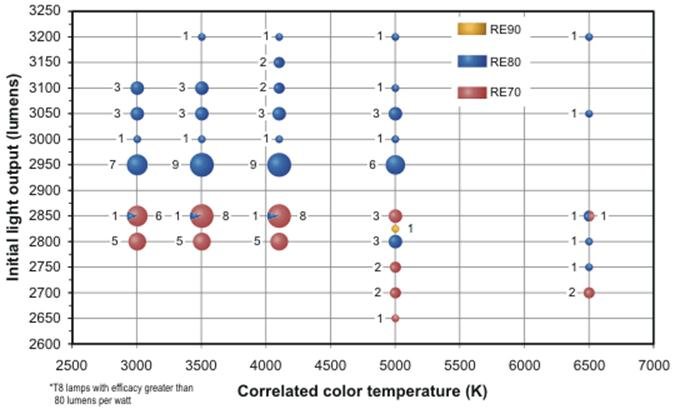T8 Lighting:What Is The Actual Lumen Output For T8 Fluorescent Bulbs?
Can You Really Determine The Correct Lumen Output?
Lumen outputs can vary per 4’ fluorescent bulb depending on the type, wattage and manufacture. In reality though, most people are looking for a cheap $2.50 bulb or even less.
Average initial “new” lumens (out of the package) for a 32 watt bulb at 3500k color temperature is 2850.
For 2’ bulbs at 17 watts and 3500k, you would get 1300 lumens.
With that said, the answers are misleading depending on which fluorescent bulb or fixture manufacture you’re talking too.
Are All Bulbs Manufactured To The Same Lumen Output?
No, unfortunately they are not all the same....wouldn't that be nice?
The amount of light generated by 32-watt T8 fluorescent lamps varies considerably from one lamp model to the next and from one manufacturer to another.
Figure 1 shows the range of values for rated initial light output that are presently published for 121 lamp models by nine manufacturers for different correlated color temperatures (CCT).
The number of available models for each rated initial light output is represented by the size of the bubble. As you can see, the values are ALL OVER the place.
For example:
At a CCT of 4100 K, there are nine models rated at 2950 initial lumens.
|
Figure 1. Rated initial light output of T8 fluorescent lamps*
|
| |

Here’s The Catch…..What Is The True Output And Where Does That Light Go?
The fluorescent lamp is an omni-directional light source, shooting light in every direction, and only 1/3 of that light directly lights it’s intended surface. If the tube is mounted in a troffer and even larger portion is reflected within the fixture and really never leaves it.
LED is a directional light source. It’s lumen output is measured outside the fixture or once the light actually exits the fixture. It’s usable light that is directed towards it’s intended surface vs. scattered and lost from the fluorescent source.
Other Factors That Contribute To Lumen Depreciation
Factor other lovely characteristics of Tesla’s invention that GE commercialized in the 1940’s such as 30-60% lumen depreciation from the fluorescent source (40% average light loss over it’s whopping 8,000 hour life), fixture dirt/dust depreciation factors of .9 or greater, 30% optical losses from fixture diffusers, lenses, etc., low ballast factors, etc. and the fluorescent lighting system on average produces 35% of the original total bulb lumen output on a good day.
For example:
Day 1 - You have a 4 bulb fluorescent fixture @ 2850 lumens per bulb netting 11,400 lumens. Factor in the real world lumen "robbers" from above, and you maybe see 7,410 lumens from that system on day 1.
Day 120- In a typical retail environment we might see 5,000 lumens. In other words when you put up a LED fixture such as a 45w 2'x2' against a 3 bulb T8 fluorescent 2'x4', the LED will win every time.....and use a LED 74w 2'x2' up against 4 lamp fluorescent systems all day and win.
Can You Really Control The Light Pattern Produced By A T8 Fluorescent?
No, that's nearly impossible.
The light pattern produced by a fluorescent fixture is an absolute mess to optically control. This in turn requires many more fluorescent fixtures in a typical lighting application to achieve the same lighting levels that you can get with the optically controlled LED fixture. That's one of the big reasons people are moving to LED.
With the excellent optical control of a LED, you get much more uniform lighted environment, PLUS lower wattage, PLUS much longer life.
Like To Learn More?
Download our FREE e-book about energy efficient lighting. Just click on the book cover below....